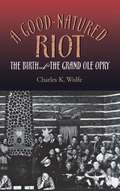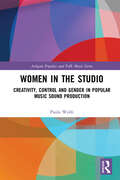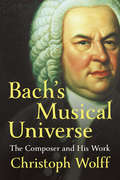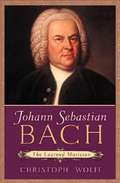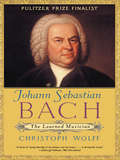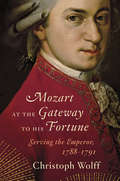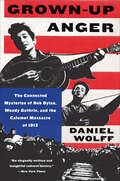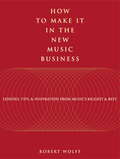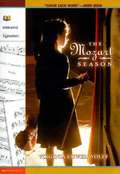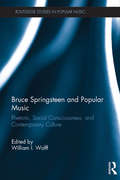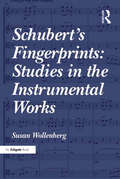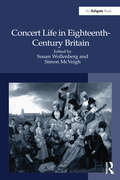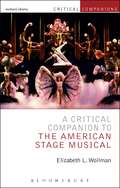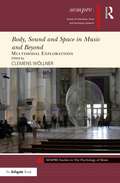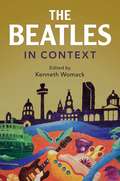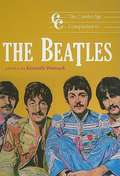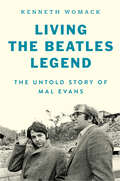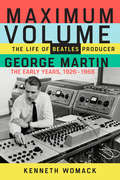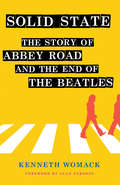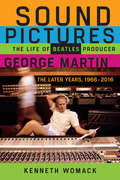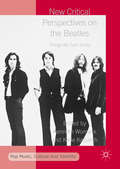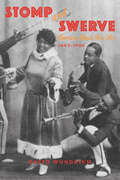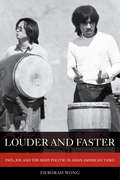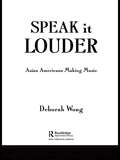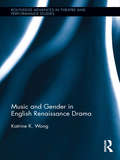- Table View
- List View
A Good-Natured Riot: The Birth of the Grand Ole Opry (Co-published with the Country Music Foundation Press)
by Charles K. WolfeWinner of the Ralph J. Gleason Music Book AwardWinner of the ASCAP Deems Taylor Award On November 28, 1925, a white-bearded man sat before one of Nashville radio station WSM's newfangled carbon microphones to play a few old-time fiddle tunes. Uncle Jimmy Thompson played on the air for an hour that night, and throughout the region listeners at their old crystal sets suddenly perked up. Back in Nashville the response at the offices of National Life Insurance Company, which owned radio station WSM ("We Shield Millions"), was dramatic; phone calls and telegrams poured into the station, many of them making special requests. It was not long before station manager George D. Hay was besieged by pickers and fiddlers of every variety, as well as hoedown bands, singers, and comedians--all wanting their shot at the Saturday night airwaves. "We soon had a good-natured riot on our hands," Hay later recalled. And, thus, the Opry was born. Or so the story goes. In truth, the birth of the Opry was a far more complicated event than even Hay, "the solemn old Judge," remembered. The veteran performers of that era are all gone now, but since the 1970s pioneering country music historian Charles K. Wolfe has spent countless hours recording the oral history of the principals and their families and mining archival materials from the Country Music Foundation and elsewhere to understand just what those early days were like. The story that he has reconstructed is fascinating. Both a detailed history and a group biography of the Opry's early years, A Good-Natured Riot provides the first comprehensive and thoroughly researched account of the personalities, the music, and the social and cultural conditions that were such fertile ground for the growth of a radio show that was to become an essential part of American culture. Wolfe traces the unsure beginnings of the Opry through its many incarnations, through cast tours of the South, the Great Depression, commercial sponsorship by companies like Prince Albert Tobacco, and the first national radio linkups. He gives colorful and engaging portraits of the motley assembly of the first Opry casts--amateurs from the hills and valleys surrounding Nashville, like harmonica player Dr. Humphrey Bate ("Dean of the Opry") and fiddler Sid Harkreader, virtuoso string bands like the Dixieliners, colorful hoedown bands like the Gully Jumpers and the Fruit Jar Drinkers, the important African American performer DeFord Bailey, vaudeville acts and comedians like Lasses and Honey, through more professional groups such as the Vagabonds, the Delmore Brothers, Bill Monroe and the Blue Grass Boys, and perennial favorite Roy Acuff and his Smoky Mountain Boys. With dozens of wonderful photographs and a complete roster of every performer and performance of these early Opry years, A Good-Natured Riot gives a full and authoritative portrayal of the colorful beginnings of WSM's barn dance program up to 1940, by which time the Grand Ole Opry had found its national audience and was poised to become the legendary institution that it remains to this day.
Women in the Studio: Creativity, Control and Gender in Popular Music Sound Production (Ashgate Popular and Folk Music Series)
by Paula WolfeThe field of popular music production is overwhelmingly male dominated. Here, Paula Wolfe discusses gendered notions of creativity and examines the significant under-representation of women in studio production. Wolfe brings an invaluable perspective as both a working artist-producer and as a scholar, thereby offering a new body of research based on interviews and first-hand observation. Wolfe demonstrates that patriarchal frameworks continue to form the backbone of the music industry establishment but that women’s work in the creation and control of sound presents a potent challenge to gender stereotyping, marginalisation and containment of women’s achievements that is still in evidence in music marketing practices and media representation in the digital era.
Bach's Musical Universe: The Composer And His Work
by Christoph WolffA concentrated study of Johann Sebastian Bach’s creative output and greatest pieces, capturing the essence of his art. Throughout his life, renowned and prolific composer Johann Sebastian Bach articulated his views as a composer in purely musical terms; he was notoriously reluctant to write about his life and work. Instead, he methodically organized certain pieces into carefully designed collections. These benchmark works, all of them without parallel or equivalent, produced a steady stream of transformative ideas that stand as paradigms of Bach’s musical art. In this companion volume to his Pulitzer Prize–finalist biography, Johann Sebastian Bach: The Learned Musician, leading Bach scholar Christoph Wolff takes his cue from his famous subject. Wolff delves deeply into the composer’s own rich selection of collected music, cutting across conventional boundaries of era, genre, and instrument. Emerging from a complex and massive oeuvre, Bach’s Musical Universe is a focused discussion of a meaningful selection of compositions—from the famous Well-Tempered Clavier, violin and cello solos, and Brandenburg Concertos to the St. Matthew Passion, Art of Fugue, and B-minor Mass. Unlike any study undertaken before, this book details Bach’s creative process across the various instrumental and vocal genres. This array of compositions illustrates the depth and variety at the essence of the composer’s musical art, as well as his unique approach to composition as a process of imaginative research into the innate potential of his chosen material. Tracing Bach’s evolution as a composer, Wolff compellingly illuminates the ideals and legacy of this giant of classical music in a new, refreshing light for everyone, from the amateur to the virtuoso.
Johann Sebastian Bach: The Learned Musician
by Christoph WolffPublished on the 250th anniversary of the composer's death, this life history portrays Bach as the human being that he was, while bringing to bear all the advances gained in the last half-century of Bach scholarship. Wolff (professor of music, and dean of the Graduate School of Arts and Sciences, Harvard U.) demonstrates the intimate connection between the composer's life and his music, showing how Bach's superb inventiveness pervaded his career as musician, composer, performer, scholar, and teacher. He also provides a look at Bach's life and his surroundings, as well as how he fit into the broader context of the institutions, traditions, and influences of his time. Annotation c. Book News, Inc., Portland, OR (booknews.com)
Johann Sebastian Bach: The Learned Musician (Música/ma Non Troppo Ser.)
by Christoph WolffFinalist for the 2001 Pulitzer Prize in Biography, this landmark book was revised in 2013 to include new knowledge discovered after its initial publication. Although we have heard the music of J. S. Bach in countless performances and recordings, the composer himself still comes across only as an enigmatic figure in a single familiar portrait. As we mark the 250th anniversary of Bach's death, author Christoph Wolff presents a new picture that brings to life this towering figure of the Baroque era. This engaging new biography portrays Bach as the living, breathing, and sometimes imperfect human being that he was, while bringing to bear all the advances of the last half-century of Bach scholarship. Wolff demonstrates the intimate connection between the composer's life and his music, showing how Bach's superb inventiveness pervaded his career as musician, composer, performer, scholar, and teacher. And throughout, we see Bach in the broader context of his time: its institutions, traditions, and influences. With this highly readable book, Wolff sets a new standard for Bach biography.
Mozart at the Gateway to His Fortune: Serving the Emperor, 1788-1791
by Christoph WolffASCAP-Deems Taylor Award winner A fresh look at the life of Mozart during his imperial years by one of the world's leading Mozart scholars. "I now stand at the gateway to my fortune," Mozart wrote in a letter of 1790. He had entered into the service of Emperor Joseph II of Austria two years earlier as Imperial-Royal Chamber Composer--a salaried appointment with a distinguished title and few obligations. His extraordinary subsequent output, beginning with the three final great symphonies from the summer of 1788, invites a reassessment of this entire period of his life. Readers will gain a new appreciation and understanding of the composer's works from that time without the usual emphasis on his imminent death. The author discusses the major biographical and musical implications of the royal appointment and explores Mozart's "imperial style" on the basis of his major compositions--keyboard,chamber, orchestral, operatic, and sacred--and focuses on the large, unfamiliar works he left incomplete. This new perspective points to an energetic, fresh beginning for the composer and a promising creative and financial future.
Grown-Up Anger: The Connected Mysteries of Bob Dylan, Woody Guthrie, and the Calumet Massacre of 1913 T
by Daniel WolffA tour de force of storytelling years in the making: a dual biography of two of the greatest songwriters, Bob Dylan and Woody Guthrie, that is also a murder mystery and a history of labor relations and socialism, big business and greed in twentieth-century America—woven together in one epic saga that holds meaning for all working Americans today.When thirteen-year-old Daniel Wolff first heard Bob Dylan’s "Like a Rolling Stone," it ignited a life-long interest in understanding the rock poet’s anger. When he later discovered "Song to Woody," Dylan’s tribute to his hero, Woody Guthrie, Wolff believed he’d uncovered one source of Dylan’s rage. Sifting through Guthrie’s recordings, Wolff found "1913 Massacre"—a song which told the story of a union Christmas party during a strike in Calumet, Michigan, in 1913 that ended in horrific tragedy. Following the trail from Dylan to Guthrie to an event that claimed the lives of seventy-four men, women, and children a century ago, Wolff found himself tracing the history of an anger that has been passed down for decades. From America’s early industrialized days, an epic battle to determine the country’s direction has been waged, pitting bosses against workers and big business against the labor movement. In Guthrie’s eyes, the owners ultimately won; the 1913 Michigan tragedy was just one example of a larger lost history purposely distorted and buried in time. In this magnificent cultural study, Wolff braids three disparate strands—Calumet, Guthrie, and Dylan—together to create a devastating revisionist history of twentieth-century America. Grown-Up Anger chronicles the struggles between the haves and have-nots, the impact changing labor relations had on industrial America, and the way two musicians used their fury to illuminate economic injustice and inspire change.
How to Make It in the New Music Business
by Robert WolffHow to Make It in the New Music Business leads both novice and professional musicians into today's digital world, helping them to take complete control over all aspects of their music, from writing and performing to recording and selling. Motivating readers to live their dreams, author Robert Wolff shows how anyone can set up and run their own music business and become a highly successful businessman or businesswoman; record major label quality music in their home, aided by tips from music professionals; broadcast that music over their own web site and radio station to a potential audience of over 500 million people via the world wide web; and do it without a major record label's support. Divided into lessons, the book focuses on such key areas of interest as: * Lesson One: Old School vs. New Reality: The Digital Revolution Levels the Playing Field * Lesson Two: Radio & Records: Learning How to Play the Game * Lesson Three: The Illusion of Needing a Record Deal: Courtney Love's Real World Wake-Up Call * Lesson Four: A View from Both Sides of the Fence: Steve Lukather on What's Right & What's Wrong with the Music Business * Lesson Five: Building Your A Team: Who You Need and Who You Don't * Lesson Six: It's All about the Song: Advice & Inspiration from Diane Warren * Lesson Seven: Developing Your Sound: Advice from Bob Bradshaw * Lesson Eight: Finding the Best Recording & Creating Platform for You: Using What the Pros Use * Lesson Nine: Mixing Your Music: Advice from Bob Clearmountain * Lesson Ten: Mastering Your Music: Advice from Bob Ludwig * Lesson Eleven: Launching the Business of "You, Inc"; Powerful Business Strategies That You Too Can Use * Lesson Twelve: Real World New Music Boot Camp: What You Need to Know About Copyrights, Music Publishing, & Licensing * Lesson Thirteen: Premiering Your Music to Listeners All Over the World: Three Steps to Broadcasting & Selling Your Music to a Global Audience The book also includes interviews with some major names in the music business, including Grammy-winning guitarist and composer Steve Lukather, Grammy-winning songwriter Diane Warren, guitar/sound system designer Bob Bradshaw, legendary engineer/producer/record mixer Bob Clearmountain, and sound mixer/masterer Bob Ludwig. How to Make It in the New Music Business is the any person's how-to, offering step-by-step advice to making it in the music business in one's own way, on own's own terms.
The Mozart Season
by Virginia Euwer WolffAllegra Shapiro decides to enter a prestigious competition for young musicians, but ends up spending the summer doing more than practicing the violin. She comes to terms with difficult issues and learns important lessons about her family and herself.
Bruce Springsteen and Popular Music: Rhetoric, Social Consciousness, and Contemporary Culture (Routledge Studies in Popular Music)
by William WolffThis interdisciplinary volume enters the scholarly conversation about Bruce Springsteen at the moment when he has reinforced his status of global superstar and achieved the status of social critic. Covering musical and cultural developments, chapters primarily consider work Springsteen has released since 9/11—that is, released during a period of continued global unrest, economic upheaval, and social change—under the headings Politics, Fear and Society; Gender and Sexual Identity; and Toward a Rhetoric of Springsteen. The collection engages Springsteen and popular music as his contemporary work is just beginning to be understood in terms of its impact on popular culture and music, applying new areas of inquiry to Springsteen and putting Springsteen fan writing within the same binding as academic writing to show how together they create a more nuanced understanding of an artist. Established and emerging Springsteen scholars approach work from disciplines including rhetoric and composition, historical musicology, labor studies, American history, literature, communications, sociology, theology, and government. Offering context, critique, and expansive understanding of Springsteen and his work, this book contributes to Springsteen scholarship and the study of popular music by showing Springsteen’s broadening academic appeal as well as his escalating legacy on new musicians, social consciousness, and contemporary culture.
Schubert's Fingerprints: Studies In The Instrumental Works
by Susan WollenbergAs Robert Schumann put it, 'Only few works are as clearly stamped with their author's imprint as his'. This book explores Schubert's stylistic traits in a series of chapters each discussing an individual 'fingerprint' with case studies drawn principally from the piano and chamber music. The notion of Schubert's compositional fingerprints has not previously formed the subject of a book-length study. The features of his personal style considered here include musical manifestations of Schubert's 'violent nature', the characteristics of his thematic material, and the signs of his 'classicizing' manner. In the process of the discussion, attention is given to matters of form, texture, harmony and gesture in a range of works, with regard to the various 'fingerprints' identified in each chapter. The repertoire discussed includes the late string quartets, the String Quintet, the E flat Piano Trio and the last three piano sonatas. Developing ideas which she first proposed in a series of journal articles and contributions to symposia on Schubert, Professor Wollenberg takes into account recent literature by other scholars and draws together her own researches to present her view of Schubert's 'compositional personality'. Schubert emerges as someone exerting intellectual control over his musical material and imbuing it with poetic resonance.
Concert Life in Eighteenth-Century Britain
by Susan Wollenberg Simon McVeighIn recent years there has been a considerable revival of interest in music in eighteenth-century Britain. This interest has now expanded beyond the consideration of composers and their music to include the performing institutions of the period and their relationship to the wider social scene. The collection of essays presented here offers a portrayal of concert life in Britain that contributes greatly to the wider understanding of social and cultural life in the eighteenth century. Music was not merely a pastime but was irrevocably linked with its social, political and literary contexts. The perspectives of performers, organisers, patrons, audiences, publishers, copyists and consumers are considered here in relation to the concert experience. All of the essays taken together construct an understanding of musical communities and the origins of the modern concert system. This is achieved by focusing on the development of music societies; the promotion of musical events; the mobility and advancement of musicians; systems of patronage; the social status of musicians; the repertoire performed and published; the role of women pianists and the 'topography' of concerts. In this way, the book will not only appeal to music specialists, but also to social and cultural historians.
A Critical Companion To The American Stage Musical (Critical Companions Series)
by Elizabeth L. Wollman Kevin G. Wetmore Patrick LonerganThis Critical Companion to the American Stage Musical provides the perfect introductory text for students of theatre, music and cultural studies. It traces the history and development of the industry and art form in America with a particular focus on its artistic and commercial development in New York City from the early 20th century to the present. Emphasis is placed on commercial, artistic and cultural events that influenced the Broadway musical for an ever-renewing, increasingly broad and diverse audience: the Gilded Age, the Great Depression, the World War II era, the British invasion in the 1980s and the media age at the turn of the twenty-first century. <P><P> Supplementary essays by leading scholars provide detailed focus on the American musical's production and preservation, as well as its influence on daily life on the local, national, and international levels. For students, these essays provide models of varying approaches and interpretation, equipping them with the skills and understanding to develop their own analysis of key productions.
Body, Sound and Space in Music and Beyond: Multimodal Explorations (SEMPRE Studies in The Psychology of Music)
by Clemens WöllnerBody and space refer to vital and interrelated dimensions in the experience of sounds and music. Sounds have an overwhelming impact on feelings of bodily presence and inform us about the space we experience. Even in situations where visual information is artificial or blurred, such as in virtual environments or certain genres of film and computer games, sounds may shape our perceptions and lead to surprising new experiences. This book discusses recent developments in a range of interdisciplinary fields, taking into account the rapidly changing ways of experiencing sounds and music, the consequences for how we engage with sonic events in daily life and the technological advancements that offer insights into state-of-the-art methods and future perspectives. Topics range from the pleasures of being locked into the beat of the music, perception–action coupling and bodily resonance, and affordances of musical instruments, to neural processing and cross-modal experiences of space and pitch. Applications of these findings are discussed for movement sonification, room acoustics, networked performance, and for the spatial coordination of movements in dance, computer gaming and interactive artistic installations.
The Beatles in Context (Composers in Context)
by Kenneth WomackSince their first performances in 1960, The Beatles' cultural influence grew in unparalleled ways. From Liverpool to Beatlemania, and from dance halls to Abbey Road Studios and the digital age, the band's impact exploded during their heyday, and has endured in the decades following their disbandment. Beatles fashion and celebrity culture, politics, psychedelia and the Summer of Love, all highlight different aspects of the band's complex relationship with the world around them. With a wide range of short, snapshot chapters, The Beatles in Context brings together key themes in which to better explore The Beatles' lives and work and understand their cultural legacy, focusing on the people and places central to The Beatles' careers, the visual media that contributed to their enduring success, and the culture and politics of their time.
The Cambridge Companion to the Beatles
by Kenneth WomackFrom Please Please Me to Abbey Road, this collection of essays tells the fascinating story of the Beatles - the creation of the band, their musical influences, and their cultural significance, with emphasis on their genesis and practices as musicians, songwriters, and recording artists. Through detailed biographical and album analyses, the book uncovers the background of each band member and provides expansive readings of the band's music. - Traces the group's creative output from their earliest recordings through their career - Pays particular attention to the social and historical factors which contributed to the creation of the band - Investigates the Beatles' unique enduring musical legacy and cultural power - Clearly organized into three sections, covering Background, Works, and History and Influence, the Companion is ideal for course usage, and is also a must-read for all Beatles fans
Living the Beatles Legend: The Untold Story of Mal Evans
by Kenneth WomackThe first full-length biography of Mal Evans, the Beatles’ beloved friend, confidant, and roadie. Malcolm Evans, the Beatles’ long-time roadie, personal assistant, and devoted friend, was an invaluable member of the band’s inner circle. A towering figure in horn-rimmed glasses, Evans loomed large in the Beatles’ story, contributing at times as a performer and sometime lyricist, while struggling mightily to protect his beloved “boys.” He was there for the whole of the group’s remarkable, unparalleled story: from the Shea Stadium triumph through the creation of the timeless cover art for Sgt. Pepper’s Lonely Hearts Club Band and the famous Let It Be rooftop concert. Leaving a stable job as telecommunications engineer to serve as road manager for this fledgling band, Mal was the odd man out from the start—older, married with children, and without any music business experience. And yet he threw himself headlong into their world, traveling across the globe and making himself indispensable. In the years after the Beatles’ disbandment, Big Mal continued in their employ as each embarked upon solo careers. By 1974, he was determined to make his name as a songwriter and record producer, setting off for a new life in Los Angeles, where he penned his memoirs. But in January 1976, on the verge of sharing his book with the world, Evans’s story came to a tragic end during a domestic standoff with the LAPD.For Beatles devotes, Mal’s life and untimely death have always been shrouded in mystery. For decades, his diaries, manuscripts, and vast collection of memorabilia was missing, seemingly lost forever…until now. Working with full access to Mal’s unpublished archives and having conducted hundreds of new interviews, Beatles’ scholar and author Kenneth Womack affords readers with a full telling of Mal’s unknown story at the heart of the Beatles’ legend. Lavishly illustrated with unseen photos and ephemera from Mal’s archives, Living the Beatles’ Legend: The Untold Story of Mal Evans is the missing puzzle piece in the Fab Four’s incredible story.
Maximum Volume: The Life of Beatles Producer George Martin, The Early Years, 1926–1966
by Kenneth WomackMaximum Volume offers a glimpse into the mind, the music, and the man behind the sound of the Beatles. George Martin's working-class childhood and musical influencesprofoundly shaped his early career in the BBC's Classical Music department and as head of the EMI Group's Parlophone Records. Out of them flowed the genius behind his seven years producing the Beatles' incredible body of work, including such albums as Rubber Soul, Revolver, Sgt. Pepper's Lonely Hearts Club Band, and Abbey Road.The first book of two, Maximum Volume traces Martin's early years as a scratch pianist, his life in the Fleet Air Arm during the Second World War, and his groundbreaking work as the head of Parlophone Records, when Martin saved the company from ruin after making his name as a producer of comedy recordings. In its most dramatic moments, Maximum Volume narrates the story of Martin's unlikely discovery of the Beatles and his painstaking efforts to prepare their newfangled sound for the British music marketplace. As the story unfolds, Martin and the band craft numerous number-one hits, progressing toward the landmark album Rubber Soul—all of which bear Martin's unmistakable musical signature.
Solid State: The Story of "Abbey Road" and the End of the Beatles
by Kenneth WomackAcclaimed Beatles historian Kenneth Womack offers the most definitive account yet of the writing, recording, mixing, and reception of Abbey Road.In February 1969, the Beatles began working on what became their final album together. Abbey Road introduced a number of new techniques and technologies to the Beatles' sound, and included "Come Together," "Something," and "Here Comes the Sun," which all emerged as classics. Womack's colorful retelling of how this landmark album was written and recorded is a treat for fans of the Beatles. Solid State takes readers back to 1969 and into EMI's Abbey Road Studio, which boasted an advanced solid state transistor mixing desk. Womack focuses on the dynamics between John, Paul, George, Ringo, and producer George Martin and his team of engineers, who set aside (for the most part) the tensions and conflicts that had arisen on previous albums to create a work with an innovative (and, among some fans and critics, controversial) studio-bound sound that prominently included the new Moog synthesizer, among other novelties. As Womack shows, Abbey Road was the culmination of the instrumental skills, recording equipment, and artistic vision that the band and George Martin had developed since their early days in the same studio seven years earlier. A testament to the group's creativity and their producer's ingenuity, Solid State is required reading for all fans of the Beatles and the history of rock 'n' roll.
Sound Pictures: The Life of Beatles Producer George Martin, The Later Years, 1966–2016
by Kenneth WomackMore than anyone besides the bandmates themselves, George Martin was the man who created the unique sound of the Beatles. Sound Pictures offers a powerful and intimate account of how he did so. <P><P> The second and final volume of the definitive biography of the man, Sound Pictures traces the story of the Beatles’ breathtaking artistic trajectory after reaching the creative heights of Rubber Soul. As the bandmates engage in brash experimentation both inside and outside the studio, Martin toils along with manager Brian Epstein to consolidate the Beatles’ fame in the face of growing sociocultural pressures, including the crisis associated with the “Beatles are more popular than Jesus” scandal. <P><P> Meanwhile, he also struggles to make his way as an independent producer in the highly competitive world of mid-1960s rock ’n’ roll. As Martin and the Beatles create one landmark album after another, including such masterworks as Revolver, Sgt. Pepper’s Lonely Hearts Club Band, The Beatles (The White Album), and Abbey Road, the internal stakes and interpersonal challenges become ever greater. <P><P> During his post-Beatles years, Martin attempts to discover new vistas of sound recording with a host of acts, including Jeff Beck, America, Cheap Trick, Paul McCartney, and Elton John, his creative breakthroughs followed by unprecedented commercial success. Eventually, though, all roads bring Martin back to the Beatles, as the group seeks out new ways to memorialize their achievement under the supervision of the man who has come to be known as Sir George. Now, more than fifty years after the Beatles’ revolutionary triumphs, Martin’s singular stamp on popular music has become more vital than ever, as successive generations discover the magic of the Beatles and their groundbreaking sound.
New Critical Perspectives on the Beatles
by Kenneth Womack Katie KapurchThe Beatles are probably the most photographed band in history and are the subject of numerous biographical studies, but a surprising dearth of academic scholarship addresses the Fab Four. New Critical Perspectives on the Beatles offers a collection of original, previously unpublished essays that explore 'new' aspects of the Beatles. The interdisciplinary collection situates the band in its historical moment of the 1960s, but argues for artistic innovation and cultural ingenuity that account for the Beatles' lasting popularity today. Along with theoretical approaches that bridge the study of music with perspectives from non-music disciplines, the texts under investigation make this collection 'new' in terms of Beatles' scholarship. Contributors frequently address under-examined Beatles texts or present critical perspectives on familiar works to produce new insight about the Beatles and their multi-generational audiences.
Stomp and Swerve: American Music Gets Hot, 1843–1924
by David WondrichThe early decades of American popular music--Stephen Foster, Scott Joplin, John Philip Sousa, Enrico Caruso--are, for most listeners, the dark ages. It wasn't until the mid-1920s that the full spectrum of this music--black and white, urban and rural, sophisticated and crude--made it onto records for all to hear. This book brings a forgotten music, hot music, to life by describing how it became the dominant American music--how it outlasted sentimental waltzes and parlor ballads, symphonic marches and Tin Pan Alley novelty numbers--and how it became rock 'n' roll. It reveals that the young men and women of that bygone era had the same musical instincts as their descendants Louis Armstrong, Elvis Presley, James Brown, Jimi Hendrix, and even Ozzy Osbourne. In minstrelsy, ragtime, brass bands, early jazz and blues, fiddle music, and many other forms, there was as much stomping and swerving as can be found in the most exciting performances of hot jazz, funk, and rock. Along the way, it explains how the strange combination of African with Scotch and Irish influences made music in the United States vastly different from other African and Caribbean forms; shares terrific stories about minstrel shows, "coon" songs, whorehouses, knife fights, and other low-life phenomena; and showcases a motley collection of performers heretofore unknown to all but the most avid musicologists and collectors.
Louder and Faster: Pain, Joy, and the Body Politic in Asian American Taiko (American Crossroads #55)
by Deborah WongA free open access ebook is available upon publication. Learn more at www.luminosoa.org.Louder and Faster is a cultural study of the phenomenon of Asian American taiko, the thundering, athletic drumming tradition that originated in Japan. Immersed in the taiko scene for twenty years, Deborah Wong has witnessed cultural and demographic changes and the exponential growth and expansion of taiko particularly in Southern California. Through her participatory ethnographic work, she reveals a complicated story embedded in memories of Japanese American internment and legacies of imperialism, Asian American identity and politics, a desire to be seen and heard, and the intersection of culture and global capitalism. Exploring the materialities of the drums, costumes, and bodies that make sound, analyzing the relationship of these to capitalist multiculturalism, and investigating the gender politics of taiko, Louder and Faster considers both the promises and pitfalls of music and performance as an antiracist practice. The result is a vivid glimpse of an Asian American presence that is both loud and fragile.
Speak it Louder: Asian Americans Making Music
by Deborah WongSpeak It Louder: Asian Americans Making Music documents the variety of musics-from traditional Asian through jazz, classical, and pop-that have been created by Asian Americans. This book is not about "Asian American music" but rather about Asian Americans making music. This key distinction allows the author to track a wide range of musical genres. Wong covers an astonishing variety of music, ethnically as well as stylistically: Laotian song, Cambodian music drama, karaoke, Vietnamese pop, Japanese American taiko, Asian American hip hop, and panethnic Asian American improvisational music (encompassing jazz and avant-garde classical styles). In Wong's hands these diverse styles coalesce brilliantly around a coherent and consistent set of questions about what it means for Asian Americans to make music in environments of inter-ethnic contact, about the role of performativity in shaping social identities, and about the ways in which commercially and technologically mediated cultural production and reception transform individual perceptions of time, space, and society. Speak It Louder: Asian Americans Making Music encompasses ethnomusicology, oral history, Asian American studies, and cultural performance studies. It promises to set a new standard for writing in these fields, and will raise new questions for scholars to tackle for many years to come.
Music and Gender in English Renaissance Drama (Routledge Advances in Theatre & Performance Studies)
by Katrine K. WongThis book offers a survey of how female and male characters in English Renaissance theatre participated and interacted in musical activities, both inside and outside the contemporary societal decorum. Wong’s analysis broadens our understanding of the general theatrical representation of music, or musical dramaturgy, and complicates the current discussion of musical portrayal and construction of gender during this period. Wong discusses dramaturgical meanings of music and its association with gender, love, and erotomania in Renaissance plays. The negotiation between the dichotomous qualities of the heavenly and the demonic finds extensive application in recent studies of music in early modern English plays. However, while ideological dualities identified in music in traditional Renaissance thinking may seem unequivocal, various musical representations of characters and situations in early modern drama would prove otherwise. Wong, building upon the conventional model of binarism, explores how playwrights created their musical characters and scenarios according to the received cultural use and perception of music, and, at the same time, experimented with the multivalent meanings and significance embodied in theatrical music.
